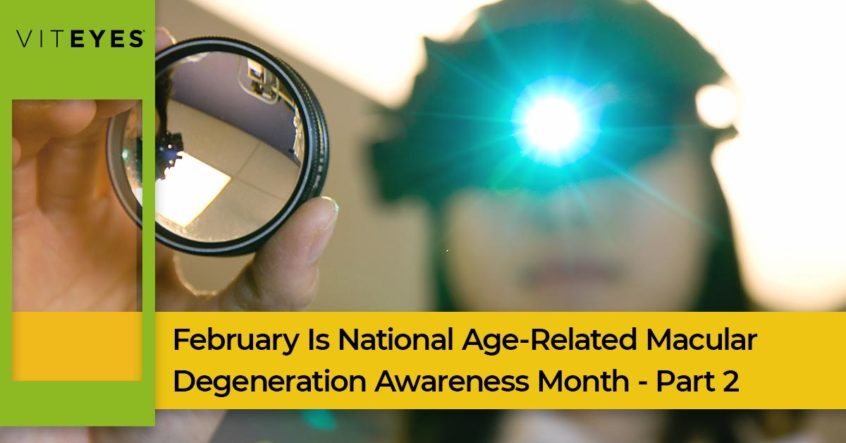Welcome back to part two of our age-related macular degeneration (AMD) series. In part one, we discussed what AMD is and who is at an increased risk of disease development. In today’s post, we will continue the discussion with ways you can reduce your risk of developing AMD, treatment options, and the global future of AMD.
How can you reduce your risk of AMD?
As we have discussed, there is no known cure for AMD, but there are things you can do to help reduce your risk of developing age-related macular degeneration. An ounce of prevention is worth a pound of cure, and doing what you can to prevent AMD is literally worth your vision. Some of the things you can do to reduce your risk of AMD include simply knowing your risk-factors and doing what you can to reduce them. This is why the American Academy of Ophthalmology (AAO) takes each February to raise awareness about the disease and educate as many people as possible of their risk factors and how to reduce them. Some things you can do include:
- Protect your eyes with sunglasses
- Don’t smoke, or stop if you are currently a smoker.
- Maintain a healthy weight and diet.
- Exercise regularly.
- Keep blood pressure within a normal range.
- Take supportive eye health supplements that include:
- Vitamin C
- Vitamin E
- Lutein
- Zeaxanthin
- Zinc
- Copper
The inclusion of the eye supplements listed above is based on the National Eye Institute’s AREDS 2 study and resulted in the creation of some of Viteyes’ vitamins including Viteyes Classic AREDS 2 formula, Viteyes AREDS 2 Advanced formula, Viteyes AREDS 2 Plus Omega-3, and Viteyes AREDS 2 Powder. View our complete AREDS 2 online resource here.

Are there treatment options for AMD?
Eye supplements can help maintain long-term eye health. All Viteyes eye vitamins are available in our online eye supplement shop without a prescription. However, there is still no known cure for the irreversible damage that causes age-related macular degeneration. There are some treatment options that can help slow the progression of the disease and protect your vision. Eye injections and laser surgery in the early stages of AMD offer hope of slowing or stopping further macular damage.
The future of age-related macular degeneration
The future of AMD is bright, despite the estimation of the occurrence of AMD doubling by 2050. Promising research is exploring treatment options that include retinal cell transplants, radiation therapy, gene therapy, computer chip retina implants to stimulate and restore vision, and drugs to prevent or slow the progression of the disease and prevent new blood vessel growth under the macula.
The AAO and Viteyes believe that a hopeful future depends largely on widespread awareness, education, and prevention. With movements like dedicating the entire month of February to the cause and organizations working hard to get the word out, more people can begin making efforts to reduce their risk and avoid AMD altogether.
If you are interested in eye vitamins that support your macular health, Viteyes has the supplements you need! We offer several different vitamins to meet your needs and help support optimal eye health. To learn more about macular health and macular degeneration, visit our online resource for these topics today. Visit our online eye supplement shop today.
